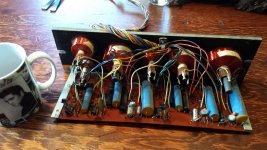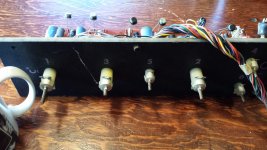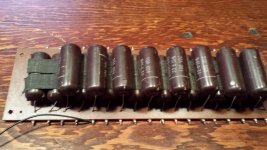Hi Guys.
I pulled 12 of these boards from an old organ. The little donuts are coated wire, like the type used for guitar pickups. I guess they are variable inductors or something like that.
Didn't have the heart to throw them in the recycling. Do they have value?
Also, got a bunch of these .22 mf 400 volt caps. About six boards I think. Not sure what to do with them either..
I pulled 12 of these boards from an old organ. The little donuts are coated wire, like the type used for guitar pickups. I guess they are variable inductors or something like that.
Didn't have the heart to throw them in the recycling. Do they have value?
Also, got a bunch of these .22 mf 400 volt caps. About six boards I think. Not sure what to do with them either..
Attachments
Whoa, very nice things for a rest-o-mod. Imagine if you wanted to commission these parts. They'd cost a fortune. That doesn't mean you'll get a fortune, but I'm sure worth the effort of putting them on eBay.
12? One per semitone probably. Then there's the question of octaves. These oscillators will be mixed somehow to generate the various tones.
Anybody will want to know that the coils are not open circuit, and the condition of the boards, any connectors.
Maybe somebody wants them for a repair? What was the make and model?
12? One per semitone probably. Then there's the question of octaves. These oscillators will be mixed somehow to generate the various tones.
Anybody will want to know that the coils are not open circuit, and the condition of the boards, any connectors.
Maybe somebody wants them for a repair? What was the make and model?
I see what looks like vintage germanium transistors. These have a cult following amongst a small group of vintage solid state guys.
I find them excellent for making clones of the Dallas Arbiter Fuzz Face, and Vox Tone Bender type of guitar stomp box from the 1960's. Only 60's vintage germanium will give the correct sound in these units.
I find them excellent for making clones of the Dallas Arbiter Fuzz Face, and Vox Tone Bender type of guitar stomp box from the 1960's. Only 60's vintage germanium will give the correct sound in these units.
An hour (or overnight, depending on how old your rustkill is) in a can of rust kill might halt the invading army. And then to reseal it a coat of gloss maybe.
I would cover the pins with masking tape before spraying them though (to avoid the gloss becoming an insulator)
Assuming the transistors are still air tight.
I would cover the pins with masking tape before spraying them though (to avoid the gloss becoming an insulator)
Assuming the transistors are still air tight.
Last edited:
I see what looks like vintage germanium transistors....
Interesting. How can I tell them from silicon transistors? They don't have consistent part numbers. They are engraved with a series of tiny numbers on top, but they vary.
Some read:
3G
1E
PN
Others read:
4G
1E
DG
Another:
3E
1E
G
Not to be a jerk, but that's quite a "patina" on the metal transistor cans, right? I predict "not long for this world" before the evil chloride ions breach the castle… ;-)
Maybe you could grind it out and seal it from further corrosion…? Not clear!
It seems to be the aluminum oxidizing where the paint has come off. It's happening on about 1/3 of them.
(I have 72 of them.)
It seems to be the aluminum oxidizing where the paint has come off. It's happening on about 1/3 of them.
(I have 72 of them.)
Actually the top hats are steel. Tested one with a magnet..
Interesting. How can I tell them from silicon transistors? They don't have consistent part numbers. They are engraved with a series of tiny numbers on top, but they vary.
.......
If you do an ohms test, the forward diodes will be much lower V than silicon. 0.1 to 0.2V
The reverse will be quite leaky. Most Ge devices were PNP. NPN were more difficult to make.
They look similar to Russian Ge transistors of the 60's era. See also this:
AMZ-FX Guitar Effects Blog Blog Archive Russian Germanium Transistors
AMZ-FX Guitar Effects Blog Blog Archive Russian Germanium Transistors
They look similar to Russian Ge transistors of the 60's era. See also this:
AMZ-FX Guitar Effects Blog Blog Archive Russian Germanium Transistors
Haha, that's kind of funny. These came out of a 1961 American built organ. The Cuban Missle Crisis happened in 1962.
Pretty safe bet we weren't making our organs with imported Russian electronics.
Also, Russians use the Cyrillic alphabet. These have Roman lettering.
Actually, these look identical to the GE 2n107. Though they are unmarked, so they are probably a competing brand.
Actually, these look identical to the GE 2n107. Though they are unmarked, so they are probably a competing brand.
They are probably GE's. They would sell bulk unmarked devices to OEM's and since marking took time and the price was cheaper for unmarked devices.
It is also possible that the organ's manufacturer bought bulk devices that didn't quite meet all the published specs. They would have left GE unmarked. GE did this a lot with their vacuum tubes in the 60's and 70's.
There was a surplus store in Miami that sold cheap rejected GE tubes under the "Best Test" or "Thoro Test" labels for cheap. How cheap, a 6L6GC for 99 cents. I used them in guitar amps and only had 1 or 2 blow up! The tubes were clearly GE with the EIA 185 cone and "dots" but no other brand except what the rebrander put on them.
The lead with the furthest spacing is the collector, base is in the middle.
Actually many Russian components were copies of western parts. And I am sure they did not buy any license...Haha, that's kind of funny. These came out of a 1961 American built organ. The Cuban Missle Crisis happened in 1962.
Pretty safe bet we weren't making our organs with imported Russian electronics.
Also, Russians use the Cyrillic alphabet. These have Roman lettering.
Actually, these look identical to the GE 2n107. Though they are unmarked, so they are probably a competing brand.
Actually many Russian components were copies of western parts. And I am sure they did not buy any license...
Sorry, just noticed you are in Hungary and probably don't know that the USA did not import ANY electronic components AT ALL from Russia during the late 50's and 60's. We were in a cold war with them and there was virtually NO trade at all with them.
They may have copied our stuff, but we sure as HeII didn't buy it from them.
We imported very little electronics at all back then, and certainly nothing from communist dictatorships.
These are American made transistors. Possibly west European. But not Russian. Period.
The Russian stuff you see in Hungary did not come here.
- Status
- This old topic is closed. If you want to reopen this topic, contact a moderator using the "Report Post" button.
- Home
- Design & Build
- Parts
- I don't even know what these are. Any value?


